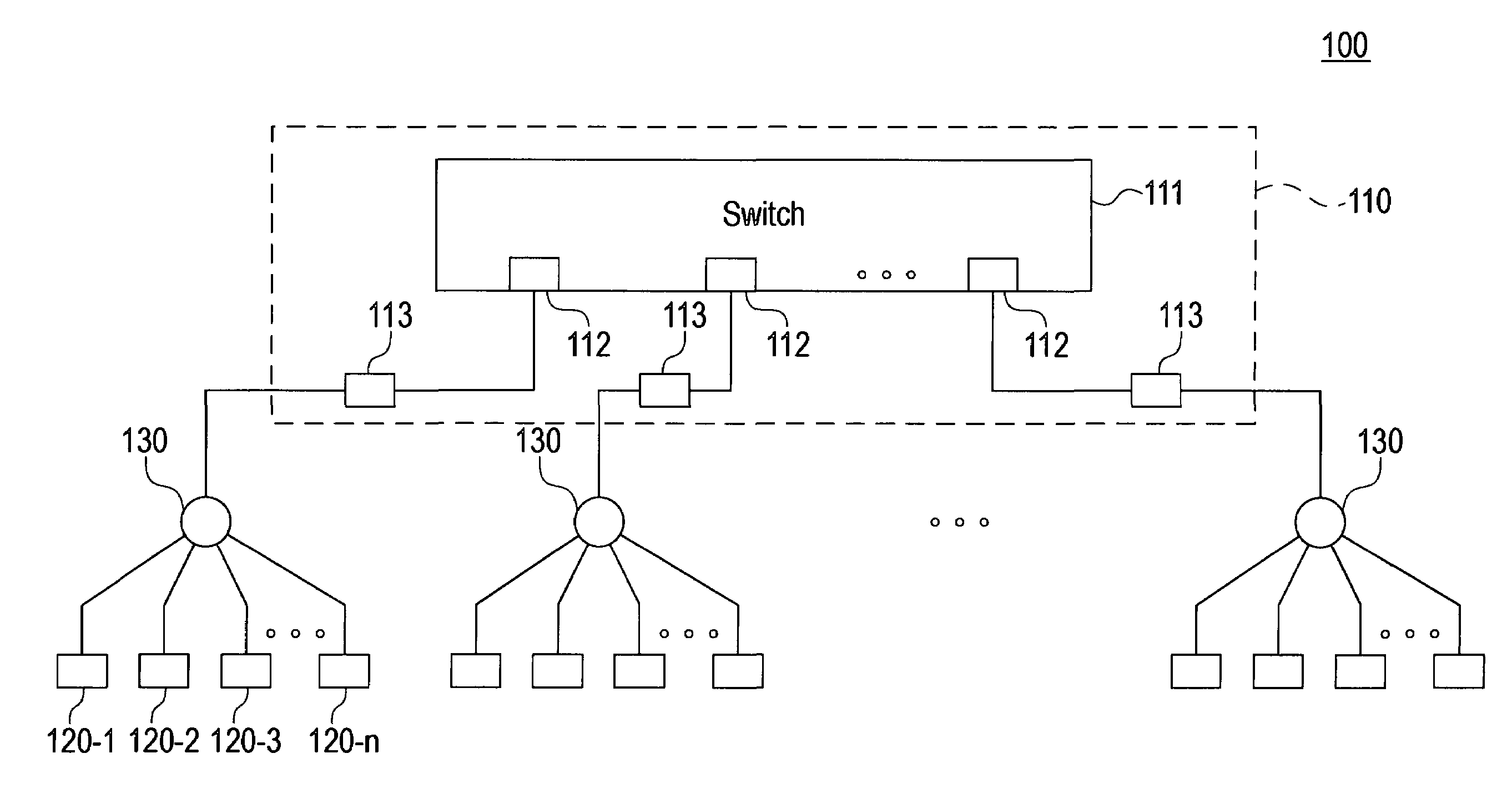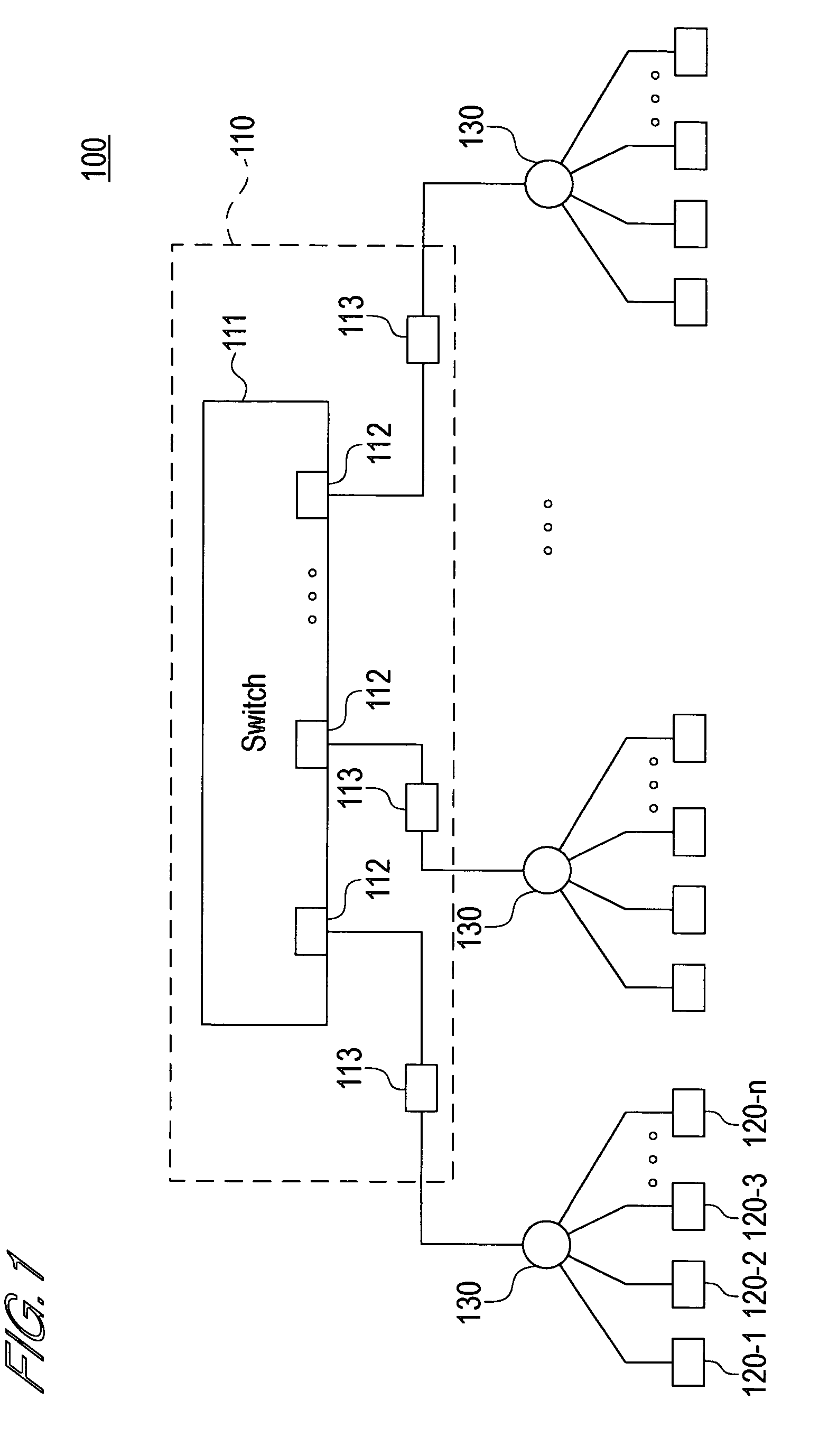Optical communication network using a code division multiplexing method
a technology of optical communication network and code division, applied in the field can solve the problems of increasing assembly cost and maintenance cost of optical communication network, destroying information stored in atm cells, and requiring more complex control of uplink direction time division multiplexing, so as to avoid optical signals and assembly at low cost, the effect of increasing throughpu
- Summary
- Abstract
- Description
- Claims
- Application Information
AI Technical Summary
Benefits of technology
Problems solved by technology
Method used
Image
Examples
first embodiment
[0025]The first embodiment of the present invention will now be described by taking an example in which the present invention is applied to a gigabit Ethernet communication network.
[0026]FIG. 1 is a block diagram that schematically shows the overall constitution of the optical communication network relating to this embodiment. Further, FIG. 2 shows the internal constitution of the accommodation device and communication terminals of FIG. 1. Only the constitution corresponding to a single port of the accommodation device is shown in FIG. 2.
[0027]As shown in FIG. 1, the optical communication network 100 relating to this embodiment comprises an accommodation device 110; a plurality of optical couplers 130, 130, . . . ; a plurality of communication terminals 120-1 to 120-n; electrical transmission paths 141, 144; and optical transmission paths 142, 143. As will be described subsequently, according to this embodiment, OCDM (Optical Code Division Multiplexing) technology is employed for up...
second embodiment
[0073]Next, the second embodiment of the present invention will be described by using FIGS. 7 and 8.
[0074]With the optical communication network relating to this embodiment, the constitution of the OCDM terminal and OCDM transceivers differs from that of the network of the first embodiment.
[0075]FIG. 7 is a block diagram showing the constitution of the OCDM terminal relating to this embodiment. In FIG. 7, the constituent elements assigned the same reference symbols as FIG. 3 are the same as those in FIG. 3.
[0076]As shown in FIG. 7, the OCDM terminal of this embodiment comprises a NACK packet assignment circuit 701.
[0077]When the decision circuit 303 decides that a data anomaly has occurred, the NACK packet assignment circuit 701 inputs data NT1 to NTn indicating this decision result. Then, a MAC frame in which information indicating this decision result is stored is generated and transmitted to the E / O converter 306. This MAC frame is converted into an optical signal by the E / O conv...
third embodiment
[0087]Next, the third embodiment of the present invention will be described by using FIGS. 9 and 10.
[0088]In the case of the optical communication network relating to this embodiment, the constitution of the OCDM terminal and OCDM transceivers differs from that of the network of the first embodiment.
[0089]FIG. 9 is a block diagram showing the constitution of the OCDM terminal relating to this embodiment. In FIG. 9, the constituent elements assigned the same reference symbols as in FIG. 3 are the same as those of FIG. 3.
[0090]As shown in FIG. 9, the OCDM terminal of this embodiment comprises optical de-spreaders 901-1 to 901-n and O / E converters 902-1 to 902-n.
[0091]The optical de-spreaders 901-1 to 901-n receive an input of an optical signal from the optical transmission path 142. The same optical signal is input to each of the optical de-spreaders 901-1 to 901-n. The optical de-spreader 901-1 performs de-spreading that corresponds with the spreading code C1. As a result, the OCDM t...
PUM
 Login to View More
Login to View More Abstract
Description
Claims
Application Information
 Login to View More
Login to View More - R&D
- Intellectual Property
- Life Sciences
- Materials
- Tech Scout
- Unparalleled Data Quality
- Higher Quality Content
- 60% Fewer Hallucinations
Browse by: Latest US Patents, China's latest patents, Technical Efficacy Thesaurus, Application Domain, Technology Topic, Popular Technical Reports.
© 2025 PatSnap. All rights reserved.Legal|Privacy policy|Modern Slavery Act Transparency Statement|Sitemap|About US| Contact US: help@patsnap.com



